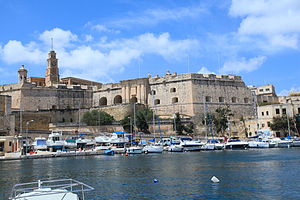Fortifications of Senglea
| Fortifications of Senglea | |
|---|---|
| Is-Swar tal-Isla | |
| Senglea, Malta | |

Senglea Land Front
|
|

Map of Senglea's fortifications as they are today
|
|
| Coordinates | 35°53′4.4″N 14°31′8.1″E / 35.884556°N 14.518917°E |
| Type | City wall |
| Site information | |
| Owner | Government of Malta |
| Condition | Partially intact |
| Site history | |
| Built | 1552–18th century |
| Built by | Order of Saint John |
| Materials | Limestone |
| Battles/wars |
Great Siege of Malta (1565) Siege of Malta (1798–1800) |
The fortifications of Senglea (Maltese: Is-Swar tal-Isla) are a series of defensive walls and other fortifications which surround the city of Senglea, Malta. The first fortification to be built was Fort Saint Michael in 1552, and the majority of the fortifications were built over the next decade when it was founded by Grand Master Claude de la Sengle. Modifications continued until the 18th century, but large parts of the fortifications were demolished between the 19th and 20th centuries. Today, all that remain of Senglea's fortifications are the seaward bastions and part of the land front.
Senglea's fortifications have been on Malta's tentative list of UNESCO World Heritage Sites since 1998, as part of the Knights' Fortifications around the Harbours of Malta.
The city of Senglea and its fortifications were built as a result of the attack of 1551. After the attack, the Order of Saint John realized the need to build more defences, and a year later, two forts began to be built. The first of these was Fort Saint Elmo at the tip of the Sciberras Peninsula (now Valletta), while the second was Fort Saint Michael, which was built on a peninsula known as l'Isola. In 1553, the entire peninsula began to be surrounded by fortifications, and was later developed into a city. It was named Senglea after the ruling Grand Master, Claude de la Sengle.
The city played an important role in the Great Siege of Malta of 1565, when it was repeatedly attacked by the invading Ottoman forces. It did not fall, and was given the title of Città Invicta (unconquered city). After the siege, the Order began to build its new capital of Valletta, and in the meantime Senglea was neglected. The architect Francesco Laparelli even proposed that the city should be razed. Eventually, this proposal was ignored and the city's defences were repaired, being completed by 1581.
...
Wikipedia

